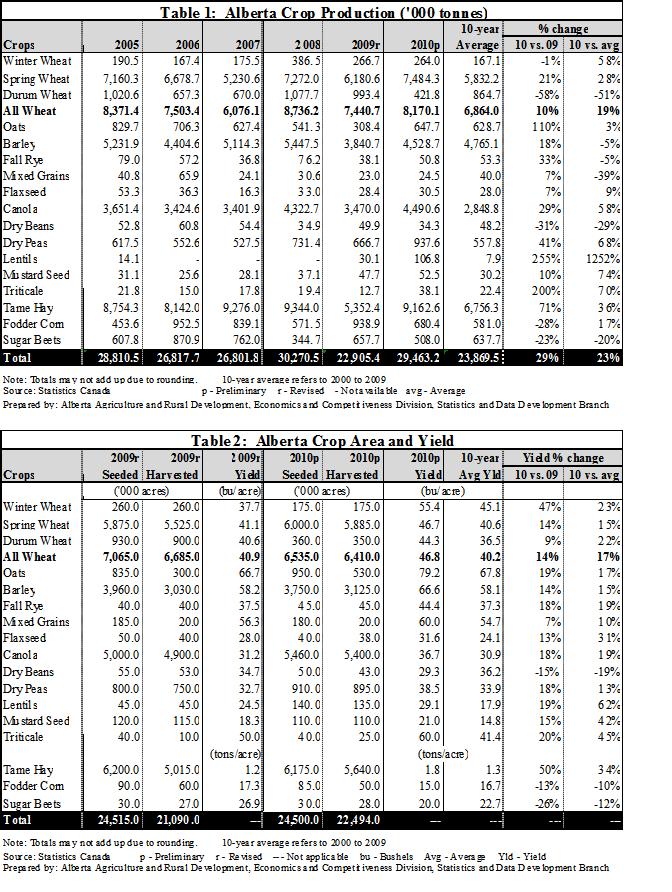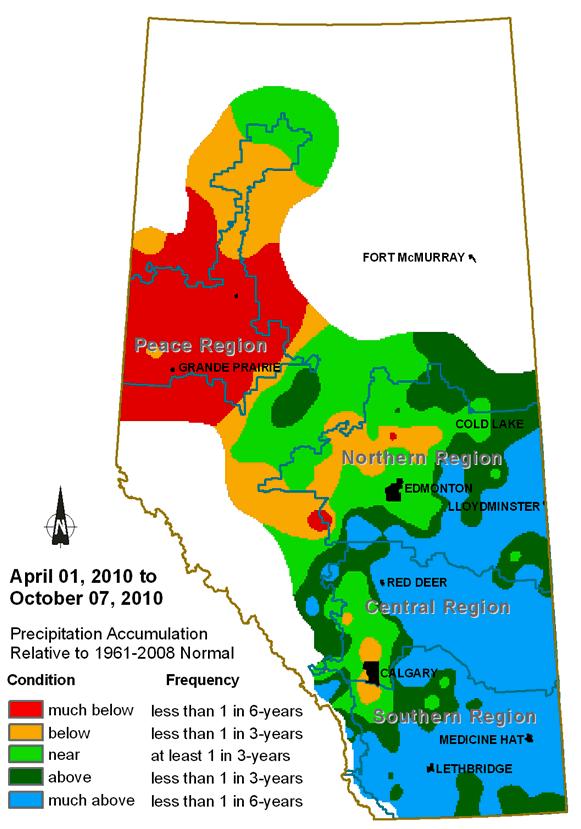| |
The 2010 Crop season | Insects and crop diseases | Forage and pasture | Alberta crop production, 2010 | Alberta forage production, 2010 | Alberta crop production tables | Precipitation Map
This report presents a review of the crop season and an analysis of crop production statistics for 2010. In addition, a precipitation map for the 2010 crop season is attached for reference.
The 2010 Crop Season
Overall, crop growing conditions in Alberta in 2010 were mainly favorable. The exception was the Peace Region, where dry conditions persisted through much of the crop season. As well, flooding in June resulted in some crop losses, mainly in the Southern Region.
The 2010 crop season in the Peace Region began with dry conditions, which allowed seeding to progress. Elsewhere in the province, cool, damp conditions delayed crop seeding and emergence. In June, heavy rain caused flooding and some crop losses, and due to the excessive moisture, some fields were left unseeded. This occurred mainly in the Southern Region, and to a much lesser extent in the Central, North East and North West Regions. Some reseeding occurred across the province.
In July, moisture and crop conditions in the Peace Region deteriorated, due to the lack of precipitation. For the rest of the province, rain continued to bring various amounts of moisture, and crops were generally in good condition. However, crop development was significantly behind normal, mainly as a result of the delayed seeding.
Crop growing conditions in August were generally favorable, despite some below seasonal temperatures. The exception was the Peace Region, where the lack of moisture took a toll on crop yields. This also led to earlier crop maturity and harvest than in most years. For the rest of the province, harvest was delayed, due to late maturing crops.
In September, cool temperatures and rain showers delayed crop maturity and harvest. These factors, coupled with several killing frosts, resulted in a significant deterioration in crop quality. Weather conditions in October were mainly warm and dry, allowing harvest to progress rapidly. By the end of October, harvest was virtually completed. In most years, harvest is usually finished in early October.
Overall, crop yields in the province in 2010 ranged from average to significantly above average. The Peace Region was the exception, where yields were markedly below average, due to dry conditions. In terms of crop quality, grade estimates for both cereals and oilseeds were below average, mainly as a result of the cool, damp conditions and frost damage in the fall. Some annual crops, mostly spring cereals, were also taken off for forage production, or used for grazing.
Insects and Crop Diseases
Due to the prevailing cool, damp conditions in 2010, insect infestations were less severe, compared to most years. Some areas reported problems or had concerns with gophers, lygus bugs, flea beetles, grasshoppers, army cutworms, wireworms, root maggots, and diamond back larvae/moths, with pesticides being applied.
Damp weather conditions in summer contributed to crop diseases in many areas. In particular, higher than normal levels of disease in canola (e.g. sclerotinia and black leg) occurred in the Central and North East Regions. Spraying for sclerotinia was reported in many areas.
Forage and Pasture
In May, pasture showed good growth in the Southern Region and in most areas of the Central Region. Elsewhere in the province, growth was slow. Some producers, primarily in the North East and North West Regions, had inadequate feed supplies, and cattle were grazing pasture, despite the limited growth.
Pasture growth benefited significantly from the moisture received in June and July. The exception was the Peace Region, where the lack of precipitation took a heavy toll on pasture conditions. As of July 29, 2010, pasture in the province was rated as 14 per cent poor, 15 per cent fair, 53 per cent good, and 18 per cent excellent.
The mainly favorable weather conditions in August were beneficial to pasture growth. However, the further deterioration of pasture conditions in the Peace Region resulted in a decline in the overall rating of pasture in the province. As of August 26, 2010, pasture in the province was reported as 15 per cent poor, 20 per cent fair, 48 per cent good, and 17 per cent excellent. In September, pasture in the Peace Region was mostly rated as poor, while for the rest of the province, pasture conditions ranged from fair to good.
With respect to tame hay, provincial yields and production were significantly above average, mainly as a result of adequate moisture during the 2010 crop season. The exception was the Peace Region, where dry conditions markedly reduced hay yields and production. Overall, hay quality varied, ranging from poor to excellent. To help secure forage supplies, some annual crops were harvested for greenfeed and silage production. Also, some straw baling was done across the province.
Alberta Crop Production, 2010
On December 3, 2010, Statistics Canada released its third and final production report for the year entitled “November Estimates of Production of Principal Field Crops, Canada, 2010”. Based on the report, total 2010 production of principal field crops in Alberta, including major/specialty crops and forages, was estimated at 29.5 million tonnes (see Table 1). This was 29 per cent higher than 2009, and 23 per cent above the 10-year average, due to higher yields and increased harvested area. In general, provincial average yields were significantly higher than in 2009, and their 10-year averages (see Table 2). Regarding crop quality, grade estimates were below average, due to a combination of late maturing crops, and adverse weather conditions in the fall, including frost, cool temperatures and rain. Total seeded area of principal field crops in the province remained relatively unchanged from 2009, while harvested acreage rose nearly seven per cent. Total summerfallow area was estimated at 1.7 million acres, an increase of three per cent over 2009.
With respect to specific crops, total production of spring wheat increased 21 per cent, to 7.5 million tonnes. This stemmed mostly from higher yields, even though harvested area was up. The provincial average yield was estimated at 46.7 bushels per acre, 14 per cent higher than in 2009, while harvested area increased seven per cent, to 5.9 million acres. For durum wheat, production declined 58 per cent, to 421,800 tonnes, as a result of the marked reduction in harvested area (down 61 per cent). The provincial average yield was estimated at 44.3 bushels per acre, up nine per cent from 2009. Overall, total production of all wheat reached 8.2 million tonnes, an increase of ten per cent over 2009.
In 2010, total barley production rose 18 per cent, to 4.5 million tonnes. The provincial average yield was 66.6 bushels per acre, or 14 per cent higher than in 2009, while harvested area increased three per cent. For oats, total production more than doubled from last year, to 647,700 tonnes. Higher yields and an increase in harvested acreage were behind the gain. The provincial average yield was estimated at 79.2 bushels per acre, or 19 per cent higher than in 2009, while the harvested area was up 77 per cent.
Total canola production increased 29 per cent from 2009, to a record 4.5 million tonnes. This was attributed to a combination of higher yields and a larger harvested area. In 2010, seeded and harvested acreage was estimated at 5.5 million acres and 5.4 million acres, respectively (both record highs). The provincial average yield was estimated at 36.7 bushels per acre, or 18 per cent above 2009.
In 2010, total production of dry peas increased 41 per cent, to a record 937,600 tonnes. Driving the increase were higher yields and a record harvested area. The provincial average yield was estimated at 38.5 bushels per acre, or 18 per cent higher than in 2009, while harvested area increased 19 per cent.
Alberta Forage Production, 2010
Total tame hay production in Alberta was estimated at 9.2 million tonnes, based on the Statistics Canada report “November Estimate of Production of Principal Field Crops, Canada, 2010”. This was up significantly by 71 per cent from 2009, and driven by higher yields and a larger harvested area. Also, the high production reduced the need for greenfeed and silage.
Based on a survey conducted by the Statistics and Data Development Branch of Alberta Agriculture and Rural Development, total greenfeed production in the province declined 19 per cent from 2009, to 1.7 million tonnes. The lower production was attributed to a marked decline in harvested area (down 53 per cent). For silage, total production was estimated at 3.9 million tonnes, up 14 per cent from 2009, as higher yields more than offset the reduction in harvested area.
Total area harvested for greenfeed declined 53 per cent from 2009, to 575,000 acres, while silage acreage dropped 40 per cent, to 570,000 acres. The mainly favorable crop growing conditions in 2010 contributed to higher greenfeed and silage yields than in 2009. Barley and oats were the major crops harvested for greenfeed and silage production, although significant acreage of mixed grains, spring wheat and triticale were also taken off as forages.
Alberta Crop Production Tables

Precipitation Map

Source: Alberta Agriculture and Rural Development, Environmental Stewardship Division, Technology and Innovation Branch |
|